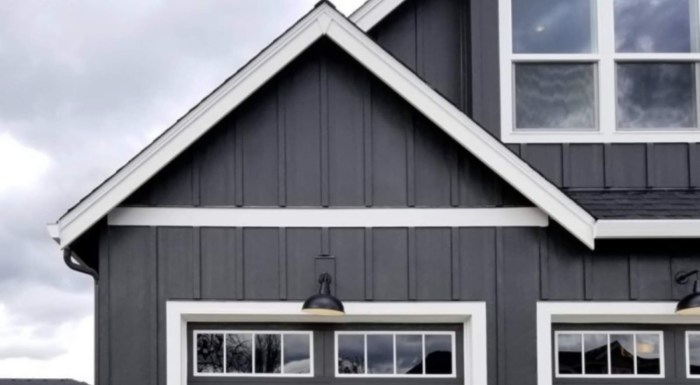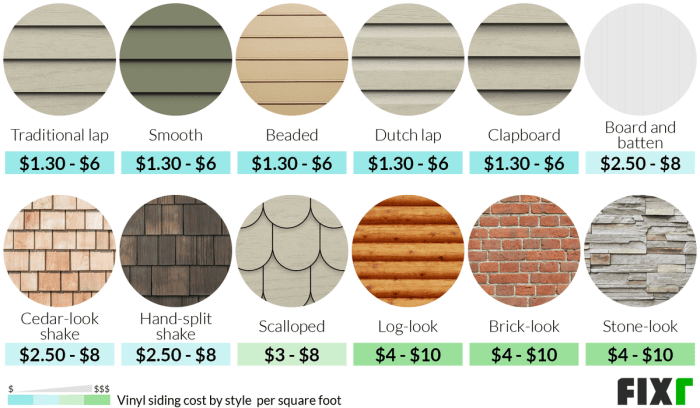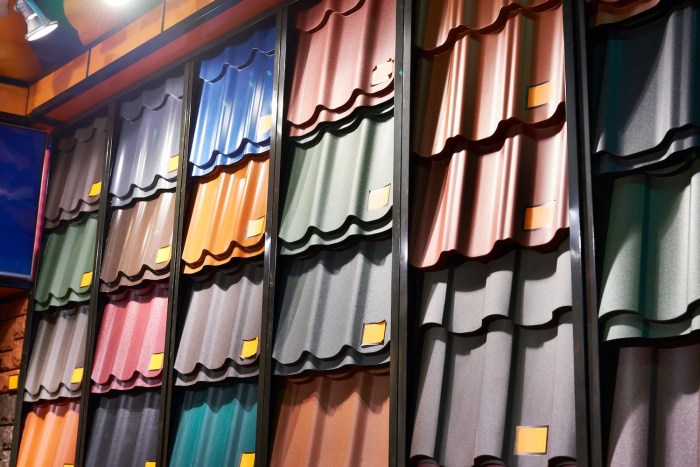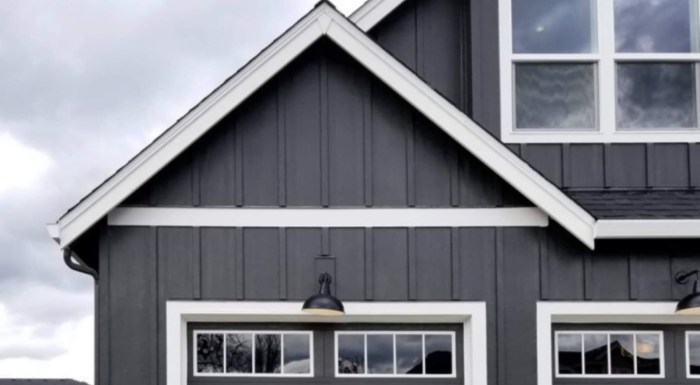Farmhouse Siding Styles: A Comprehensive Guide
Farmhouse Siding Styles
Farmhouse siding styles – Farmhouse siding, a hallmark of rustic charm and enduring appeal, evokes a sense of warmth and history. Its characteristic aesthetic is defined by a blend of simplicity and practicality, reflecting the functional needs and aesthetic preferences of rural life throughout American history.
This style emphasizes natural materials and straightforward designs, often incorporating vertical or horizontal planks in a variety of materials and finishes.
Defining Characteristics of Farmhouse Siding
Farmhouse siding is distinguished by its use of natural or natural-looking materials, often in wide, horizontal planks. The overall effect is one of unpretentious elegance. Common features include board-and-batten siding, clapboard siding, and shingle siding, often with a weathered or aged appearance.
Color palettes typically feature muted tones, such as creamy whites, soft grays, and muted blues, reflecting the natural environment. The simplicity of the design allows the natural texture and color variations of the materials to take center stage.
Common Materials Used in Farmhouse Siding
Several materials effectively capture the essence of farmhouse siding. Each offers a unique combination of cost, maintenance requirements, durability, and aesthetic appeal.
| Material | Cost | Maintenance | Durability | Aesthetic Appeal |
|---|---|---|---|---|
| Wood | High | High (requires regular painting or staining) | Moderate to High (depending on wood type and treatment) | High (natural warmth and texture) |
| Vinyl | Moderate | Low (easy to clean, requires minimal upkeep) | High (resistant to rot, insects, and moisture) | Moderate (can appear less natural than wood) |
| Fiber Cement | Moderate to High | Low (resistant to rot, insects, and fire) | High (very durable and long-lasting) | High (can mimic the look of wood) |
| Metal | Moderate to High | Low (requires minimal maintenance) | High (extremely durable and weather-resistant) | Moderate (modern aesthetic, less traditionally farmhouse) |
Historical Context and Evolution of Farmhouse Siding Styles
The evolution of farmhouse siding styles reflects the readily available materials and construction techniques of each era. Early American farmhouses frequently utilized readily available wood, often in clapboard or shingle styles. These styles provided effective protection from the elements while showcasing the natural beauty of the wood.
The development of mass-produced materials, such as vinyl and fiber cement, in the 20th century offered more affordable and low-maintenance alternatives, broadening the accessibility of the farmhouse aesthetic to a wider range of homeowners. However, the enduring appeal of the original wood siding has led to a resurgence in its popularity in recent years, with many homeowners opting for the natural look and feel of wood, even with its higher maintenance demands.
The classic aesthetic remains largely unchanged, though modern interpretations may incorporate slightly different color palettes or slight variations in plank width.
Popular Farmhouse Siding Materials

Choosing the right siding for your farmhouse is a crucial decision impacting both aesthetics and longevity. The material you select will significantly influence the overall look and feel of your home, as well as its maintenance needs and long-term cost.
This section explores some of the most popular options, highlighting their advantages and disadvantages to aid in your decision-making process.
Wood Siding for Farmhouses
Wood siding offers undeniable charm, perfectly complementing the rustic aesthetic of a farmhouse. The natural texture and warmth of wood create a timeless appeal that’s hard to replicate with other materials. However, it’s important to understand that wood requires more maintenance than other options.
Advantages of Wood Siding:Wood siding boasts a natural beauty and versatility, allowing for a wide range of finishes and colors. It’s a relatively easy material to work with for skilled builders, facilitating custom designs and intricate details. Properly maintained, wood siding can last for many decades.
Disadvantages of Wood Siding:Wood is susceptible to rot, insect infestation, and damage from harsh weather conditions. It requires regular maintenance, including painting or staining every few years, to protect it from the elements. The initial cost of high-quality wood siding can also be significant.
Maintenance Requirements for Different Types of Wood Siding, Farmhouse siding styles
The maintenance needs of wood siding vary depending on the species of wood used.
Cedar Siding:Cedar is naturally resistant to rot and insects, requiring less frequent maintenance than other woods. However, it still benefits from periodic cleaning and re-staining or painting every 5-7 years to maintain its appearance and protect it from the elements.
Regular inspections for any signs of damage are recommended.
Pine Siding:Pine is a more affordable option than cedar but is less naturally resistant to decay and insects. It typically requires more frequent maintenance, including painting or staining every 3-5 years, along with regular inspections and prompt repairs of any damaged areas.
Treating pine siding with a wood preservative can extend its lifespan.
Vinyl and Fiber Cement Siding: A Comparison
Vinyl and fiber cement are popular alternatives to wood, offering lower maintenance and often longer lifespans.
The following table compares vinyl and fiber cement siding:
| Feature | Vinyl Siding | Fiber Cement Siding |
|---|---|---|
| Appearance | Can mimic the look of wood, but often lacks the same texture and depth. | Offers a more realistic wood-like appearance with a variety of textures and colors available. |
| Longevity | Typically lasts 20-30 years, depending on quality and exposure to the elements. | Can last 50 years or more with proper installation and maintenance. |
| Cost-Effectiveness | Generally less expensive upfront than fiber cement. | Higher initial cost, but potentially more cost-effective in the long run due to its longer lifespan and lower maintenance needs. |
| Maintenance | Requires minimal maintenance; occasional cleaning. | Requires minimal maintenance; occasional cleaning; repainting may be needed after many years. |
Hypothetical Farmhouse Exterior Design
Imagine a two-story farmhouse with a wraparound porch. The main body of the house features durable and low-maintenance fiber cement siding in a warm, off-white color, providing a classic farmhouse look. The porch is clad in cedar wood siding, stained a rich, dark brown to complement the main house.
This combination offers a balance between the natural beauty of wood and the longevity of fiber cement. The contrasting siding materials create visual interest, highlighting the porch as a key architectural feature. The window trim and door frames are painted a crisp white, providing a clean contrast against the siding and enhancing the overall aesthetic appeal.
This design prioritizes both visual appeal and practicality, combining the benefits of different siding materials to achieve a beautiful and long-lasting exterior.
Common Farmhouse Siding Patterns and Textures
Farmhouse style embraces a timeless aesthetic, and a significant component of achieving this look lies in the careful selection of siding patterns and textures. The interplay of these elements creates the characteristic charm and rustic appeal associated with this architectural style.
Understanding the various options available allows for a personalized and visually engaging exterior.
The choice of siding pattern and texture significantly impacts the overall feel of a farmhouse. Whether aiming for a sleek, modern farmhouse interpretation or a more traditional, rustic aesthetic, the right combination can elevate the home’s curb appeal and character.
This section explores common patterns and textures, demonstrating how their strategic use contributes to the overall design.
Farmhouse Siding Patterns
Several siding patterns are frequently employed in farmhouse design, each contributing a unique visual effect. The following table illustrates some of the most popular choices.
| Pattern | Description | Image Description |
|---|---|---|
| Board and Batten | This classic pattern features wide vertical boards (the “boards”) with narrower strips of wood (the “battens”) covering the seams between them. It creates a clean, linear look with a slightly rustic feel. | Imagine a photograph showing a farmhouse with vertical, evenly spaced boards, approximately 6-8 inches wide, with narrower, 1-2 inch battens neatly covering the joints. The boards are painted a creamy white, and the battens are a slightly darker shade of off-white, providing subtle contrast. |
| Shiplap | Shiplap consists of overlapping horizontal boards, creating a clean, streamlined appearance. The overlapping edges create a shadow line that adds depth and texture. | Visualize a close-up image of a wall clad in shiplap. The horizontal boards are evenly spaced and slightly offset, showing a subtle groove where they overlap. The wood appears smooth and is painted a soft gray, emphasizing the linear pattern. |
| Clapboard (or Lap Siding) | Clapboard siding features overlapping horizontal boards that taper in width from bottom to top. This creates a staggered effect and adds visual interest. | Picture a farmhouse with clapboard siding, showing the graduated width of the horizontal boards. The bottom edge of each board is wider than the top, creating a layered appearance. The siding is painted a deep, warm red, enhancing the traditional farmhouse aesthetic. |
| Vertical Shiplap | A modern take on traditional shiplap, this pattern uses the same overlapping technique but in a vertical orientation. It provides a different visual rhythm and can create a taller, more slender appearance for the house. | Envision a photo of a farmhouse with vertically oriented shiplap. The overlapping boards run from top to bottom, creating a sense of height and elegance. The shiplap is stained a dark brown, highlighting the wood grain and adding a contemporary touch to the design. |
Farmhouse Siding Textures
Texture plays a vital role in establishing the overall aesthetic of a farmhouse. The choice of texture can evoke feelings of rustic charm, modern sophistication, or a blend of both. The following examples illustrate how different textures contribute to the overall design.
A smooth, painted surface on shiplap siding, for instance, creates a clean and contemporary feel. The absence of significant textural variation allows the pattern to take center stage, resulting in a sleek, minimalist look. This is often seen in modern farmhouse interpretations.
In contrast, rough-hewn wood siding provides a more rustic and traditional aesthetic. The visible texture, with its knots, grain, and imperfections, adds warmth and character. This texture might be left untreated to showcase the natural beauty of the wood or treated with a sealant to preserve its integrity while retaining the rustic feel.
A rough-hewn texture is ideal for achieving a truly traditional farmhouse look.
A combination of smooth and rough textures can create visual interest and depth. For example, using smooth painted clapboard on the main body of the house and rough-hewn wood accents around windows or dormers can provide a balanced and visually appealing design.
This blending of textures adds complexity and prevents the design from feeling monotonous.
Color Palettes and Siding Choices: Farmhouse Siding Styles
The choice of color for your farmhouse siding is a crucial design element, impacting not only the aesthetic appeal but also the overall mood and feel of your home. Careful consideration of color palettes and their interaction with the surrounding landscape can significantly enhance the charm and character of your farmhouse.
This section explores popular color palettes and their effects on the farmhouse aesthetic.
Color selection significantly influences the perceived size, warmth, and style of a farmhouse. Lighter colors, for instance, can make a home appear larger and brighter, while darker shades create a more intimate and grounded feeling. The color also interacts with the surrounding environment; a home painted in earthy tones will blend seamlessly with a rural landscape, while a bolder color might stand out as a striking focal point.
Popular Farmhouse Siding Color Palettes
Popular farmhouse siding colors often draw inspiration from nature, creating a sense of harmony and tranquility. These palettes typically feature muted, earthy tones that complement the rustic charm of farmhouse architecture.
Here are a few examples:
- Classic Cream and Gray:This palette utilizes creamy whites or off-whites for the main siding, contrasted with various shades of gray for trim, shutters, and accents. The creamy white provides a bright and airy feel, while the gray adds depth and sophistication. Imagine a soft, warm white siding like “Swiss Coffee” paired with a sophisticated gray like “Silver Sage” for trim.
This combination exudes a timeless elegance.
- Earthy Greens and Browns:This palette uses various shades of green and brown to create a natural, rustic look. Think deep forest greens like “Hunter Green” combined with warm browns like “Chocolate Brown” for a grounded, earthy feel. This color scheme blends seamlessly with natural surroundings, creating a harmonious and inviting atmosphere.
- Muted Blues and Grays:This palette offers a serene and calming effect. Soft blues, such as “Misty Blue” or “Sky Blue,” paired with muted grays, create a peaceful and tranquil ambiance. The combination of these colors evokes a sense of calmness and serenity, especially in homes situated near water or in open spaces.
- Warm Whites and Black Accents:This striking combination uses a warm white siding, like “Creamy White” or “Antique White,” contrasted with crisp black accents on window frames, doors, and trim. This palette creates a sharp, sophisticated contrast that enhances the architectural details of the farmhouse.
The black accents add a touch of modern elegance to the classic farmhouse style.
Impact of Color Choices on Farmhouse Mood and Style
The impact of color on the overall mood and style of a farmhouse is undeniable. A carefully chosen palette can either enhance the rustic charm or introduce a modern twist to the traditional aesthetic.
For example, a palette of warm, earthy tones will reinforce the rustic charm, creating a welcoming and cozy atmosphere. Conversely, a palette featuring brighter, bolder colors can inject a sense of vibrancy and modernity, creating a more contemporary feel within the farmhouse style.
The choice of color also influences the perceived size and scale of the house. Lighter colors tend to make a house appear larger, while darker colors can make it seem smaller and more intimate. The use of contrasting colors can highlight architectural details and add visual interest.
Mood Board Examples
Imagine a mood board showcasing four distinct farmhouse exteriors:
Mood Board 1: Classic Cream and Gray.This board displays a farmhouse with creamy white siding, accented by dark gray shutters and trim. The image evokes a feeling of timeless elegance and understated sophistication. The overall mood is peaceful and inviting.
Mood Board 2: Earthy Greens and Browns.This board features a farmhouse with siding in various shades of muted greens and browns. The image evokes a feeling of being grounded in nature, rustic and harmonious with its surroundings. The overall mood is warm, inviting, and tranquil.
Mood Board 3: Muted Blues and Grays.This board depicts a farmhouse with soft blue siding and gray accents. The image evokes a sense of serenity and calm. The overall mood is peaceful and tranquil.
Mood Board 4: Warm Whites and Black Accents.This board showcases a farmhouse with warm white siding and striking black accents. The image evokes a feeling of modern sophistication and classic charm. The overall mood is chic, elegant, and striking.
Modern Interpretations of Farmhouse Siding
The enduring appeal of farmhouse style continues to inspire contemporary design, leading to exciting reinterpretations of traditional siding. While the charm of classic farmhouse aesthetics remains, modern interpretations often incorporate updated materials, colors, and patterns to create a fresh and sophisticated look.
This evolution reflects a broader trend in architecture that blends timeless design elements with modern sensibilities.Modern farmhouse siding designs leverage contemporary materials and techniques to achieve a balance between rustic charm and sleek minimalism. This involves a thoughtful selection of siding materials that offer both aesthetic appeal and enhanced durability, often incorporating sustainable and low-maintenance options.
Advanced installation methods also contribute to a cleaner, more precise finish, enhancing the overall visual impact of the siding.
Modern Materials Used in Farmhouse Siding
The choice of siding material significantly impacts the overall aesthetic and longevity of a modern farmhouse exterior. While traditional wood remains a popular option, contemporary designs frequently incorporate alternative materials that offer enhanced durability, lower maintenance, and a wider range of design possibilities.
For instance, fiber cement siding provides a wood-like appearance with superior resistance to moisture, insects, and fire. Its versatility allows for a variety of textures and colors, enabling designers to achieve a range of farmhouse styles, from rustic to modern.
Another popular choice is engineered wood siding, which combines the beauty of natural wood with improved durability and stability. Engineered wood often requires less maintenance than traditional wood siding and is less susceptible to warping or cracking. Metal siding, particularly in sleek, dark colors, offers a contemporary twist on the farmhouse aesthetic, providing a clean, modern look while offering exceptional longevity and low maintenance.
Modern Farmhouse Siding Patterns and Textures
Modern interpretations of farmhouse siding often play with texture and pattern to add visual interest and depth. While traditional lap siding remains a staple, contemporary designs incorporate variations such as wider planks, vertical siding, or a combination of both to create a more dynamic facade.
The use of contrasting materials or textures, such as combining smooth fiber cement panels with rough-hewn wood accents, can add a layer of sophistication and visual intrigue. Furthermore, the incorporation of subtle variations in color or texture within a single siding material can enhance the overall aesthetic, providing a more complex and visually engaging surface.
Modern Farmhouse Exterior Design Example
Consider a two-story modern farmhouse with a gable roof. The exterior features a combination of wide, horizontally-oriented fiber cement lap siding in a warm, light gray hue, creating a clean and contemporary base. Vertical cedar planks, stained a dark charcoal gray, are strategically used to accentuate key architectural features, such as the entryway and window frames.
The contrast between the light gray and dark gray creates visual interest and depth. Black metal accents, such as window trim and downspouts, add a touch of modern sophistication, further enhancing the clean lines of the design. The overall effect is a balanced aesthetic that seamlessly blends traditional farmhouse charm with contemporary elegance.
Landscaping that includes native grasses and strategically placed shrubs completes the look, offering a natural and unfussy setting that complements the home’s design.
Last Point
Ultimately, selecting the right farmhouse siding involves a thoughtful consideration of your personal style, budget, and long-term maintenance preferences. By understanding the unique characteristics of different materials, patterns, and colors, you can create a farmhouse exterior that is both beautiful and enduring.
Whether you embrace traditional aesthetics or opt for a modern twist, the possibilities are endless, allowing for a truly personalized and captivating home exterior. We hope this guide has provided the necessary tools and inspiration to embark on your farmhouse siding journey with confidence.





